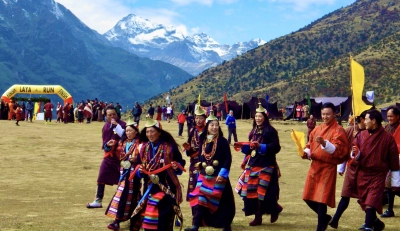Bhutan
- Home
- Bhutan
Why Bhutan
1. The Last Great Himalayan Kingdom
Situated in the Eastern Himalayas, Bhutan is a rare gem untouched by mass tourism. Known as the “Last Great Himalayan Kingdom,” it protects its pristine landscapes, from towering peaks to lush valleys, through a strict “High Value, Low Impact” tourism policy. Ancient monasteries and vibrant cultural traditions thrive here, offering visitors an authentic glimpse into a timeless way of life. Bhutan’s careful preservation of nature and heritage creates a unique destination where spirituality, culture, and breathtaking scenery blend seamlessly.
2. Guided by Gross National Happiness
For visitors, Bhutan offers more than scenic beauty—it offers a rare opportunity to witness a society where values such as compassion, mindfulness, and harmony with nature are genuinely prioritised over material gain. It’s a living example of how a nation can thrive by nurturing the soul as much as the economy.
3. Rich Spiritual and Cultural Heritage
4. Breathtaking Nature and Biodiversity
5. Sustainable and Responsible Tourism
6. Flavourful Bhutanese Cuisine
7. Wellness and Spiritual Retreats
8. National Dress and Identity
Taste Bhutan through its bold, comforting, and deeply rooted cuisine.
Bhutanese food is an experience in itself—centered around spice, simplicity, and warmth. The iconic Ema Datshi, a fiery stew of chilies and cheese, is more than just the national dish—it’s a cultural staple found in every home. Meals often feature locally grown organic vegetables, red rice, handmade noodles, and farm-fresh dairy, all prepared with minimal processing to retain their natural flavors.Dining in Bhutan is often a communal affair—shared among family or offered with generosity to guests, reflecting the Bhutanese values of hospitality and harmony. Whether you’re savoring a meal in a mountain farmhouse or a bustling local eatery, every dish tells a story of tradition, resilience, and connection to the land.
Major Festivals in Bhutan

Royal Highland Festival

Paro Tshechu

Punakha Tshechu

Thimphu Tshechu

Jambay Lhakhang Drup

Trongsa Tshechu

Black Necked Crane Festival

Haa Summer Festival

Matsutake Mushroom Festival
When Is the Best Time to Visit Bhutan?
If you search online, most results will say that Spring (March–May) and Autumn (September–November) are the best times to visit Bhutan — and it’s true that these seasons offer pleasant weather, clear skies, and great visibility. But to say they are the only best times would be an oversimplification.
Bhutan is a year-round destination, and each season offers something special depending on what you’re looking for — whether it’s festivals, nature, solitude, or luxury stays.
Spring (March to May)
Spring in Bhutan is warm and sunny, with blooming rhododendrons and vibrant forests. It’s one of the most beautiful seasons to explore the outdoors and catch cultural festivals.
- Weather: Mild days, cool nights (can be chilly early March)
- Highlights: Paro Tshechu, rhododendron blooms, trekking
- Good to know: Expect occasional rain towards the end of May
Autumn (September to November)
Autumn is another peak season with crisp air, golden rice fields, and spectacular Himalayan views. It’s also the time for some of Bhutan’s grandest festivals.
- Weather: Clear skies, comfortable temperatures, cooler evenings
- Highlights: Thimphu Tshechu, Jambay Lhakhang Drup, harvest season
- Good to know: Early and mid-autumn are best; late autumn gets colder at night
Winter (December to February)
Winter is Bhutan’s quiet season, but it comes with its own magic. Days are sunny and clear — perfect for sightseeing without the crowds. Snow adds charm to highland areas like Paro and Thimphu, while Punakha and Wangdue remain comfortably warm.
- Weather: Cold nights (may dip below zero), but sunny days (10–20°C in most places)
- Highlights: Black-necked crane season, Punakha Dromche, peaceful Dzong visits
- Advantages: Fewer tourists, best hotel availability, easy flight bookings
Summer (June to August)
Summer is the monsoon season. While southern and central regions may get rain, the northern valleys (where most tourists go) don’t experience continuous heavy rainfall. The countryside is lush and green, and it’s a peaceful time to travel.
- Weather: Warm and humid; intermittent rain; mostly cloudy
- Highlights: Waterfalls, greenery, off-season peace
- Limitations: Trekking is not ideal; views may be obstructed by clouds
So, Which Season is Best for You?
Spring & Autumn:
- Ideal for festivals, treks, and mountain views
Winter & Summer:
- Fewer tourists = more personal experiences
- Easier to get rooms at the best hotels and last-minute flight tickets
- Ideal for a relaxed, peaceful Bhutan journey
- Trekking is not recommended during these months
Best places to visit in Bhutan

Punakha Dzong
Best Time to Visit :

Paro Taktsang
Best Time to Visit :

Trongsa Dzong
Best Time to Visit :

Phobjikha Valley
Best Time to Visit :

Bumthang Valley
Best Time to Visit :

